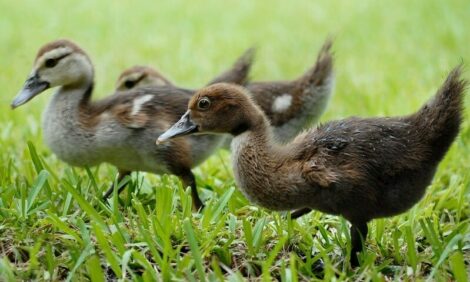



Promoting Poultry Health through Diet
US - Developing strategies to increase the amount of saleable product while reducing dietary inputs is a priority for animal scientists. University of Illinois researchers have been looking at how dietary components affect gut health and disease resistance in chickens."An important nutritional outcome is how well an animal is able to digest and metabolize its diet," said Ryan Dilger.
Poultry and swine nutritionists are concerned about dietary fiber in alternative dietary ingredients, particularly the by-products of biofuel production. Fiber concentrations are very high in these ingredients because the starch content is removed during processing.
Dilger and his master's student Emma Wils-Plotz looked at how purified fiber fed to young chicks affects their dietary threonine (Thr) requirements, intestinal morphology, and ability to resist a disease challenge. Threonine is an essential amino acid accounting for as much as 11 per cent of mucin, an important component of the mucus layer covering the intestine's absorptive surface, which promotes gut health by protecting the body against bacteria and digestive enzymes.
Previous research has suggested that mucin dynamics may be sensitive to Thr availability. Dilger and Wils-Plotz hypothesized that dietary Thr requirements would increase in the presence of two purified fiber sources, cellulose and pectin, which are natural components of many feed ingredients.
They fed diets containing purified cellulose, pectin, or silica sand (control) to chicks and found that body weight gain and feed efficiency (the conversion of feed into body-weight gain) were reduced when 7 per cent supplemental pectin was added to the diet. Pectin creates a viscous environment in the gut that interfered with the birds' ability to access dietary nutrients, thus reducing growth performance. Feeding 7 per cent purified cellulose did not provide any nutritional benefit.
In a second experiment, Wils-Plotz and Dilger quantified the dietary threonine requirement in the presence and absence of purified fiber sources. Chicks were fed one of the three fiber-containing diets. Within each diet, they were subdivided into seven groups, each fed a different level of Thr supplementation ranging from 0 to 9.6 grams per kilogram (g/kg). Contrary to the researchers' expectations, birds fed the diet with pectin had the lowest Thr requirements at 5.6 g/kg; birds fed the control diet had the highest, estimated to be 6.8 g/kg. Cellulose-fed birds required 5.8 g/kg.
Ileal tissue, which is at the end of the small intestine, was collected from chicks and examined for physical changes in the villi (small folds in the intestine), crypts (pockets next to the villi), and goblet cells, which produce and secrete mucin. Chicks fed cellulose or pectin had deeper crypts than chicks fed the control diet; crypts were deepest for birds fed cellulose and adequate Thr levels, and their outer intestinal muscle layer (serosa) was thicker. Chicks fed diets containing fiber had higher goblet cell counts than the birds fed the control diet, with highest levels in birds fed the pectin diet with adequate or high Thr levels.
The findings suggest that dietary Thr concentration and fiber source affect growth performance, intestinal morphology, and mucin secretion in young chicks. It also established optimal dietary Thr levels.
Having determined these levels, the researchers wanted to see if fiber and Thr in the diet could affect how chicks responded to a coccidiosis challenge. Coccidiosis is a parasitical disease of the intestinal tract caused by protozoa of the genus Eimeria maxima, which is responsible for major economic losses in the poultry industry.
"Right now, there are few advancements in coccidiosis vaccine development, so we tried to develop dietary approaches to assist the bird through a coccidiosis challenge," Dilger said. "Our hypothesis was that by providing adequate threonine, the bird would have better immune defenses through improved gut function and immunity."
Chicks received either a diet supplemented with pectin or a Thr-deficient control diet and either 75 per cent or 125 per cent of the previously determined optimal Thr supplement of 6.8 g/kg. Within each dietary treatment, one group of chicks was inoculated with E. maxima; the other was not.
"The goal was to determine the interaction between dietary fiber and dietary threonine, knowing that pectin was going to negatively affect digestion and threonine was going to positively affect intestinal health," Dilger explained.
Growth and feed efficiency were monitored for 16 days; then ileal tissue, mucosal scrapings, and the ceca (the part of the digestive tract used for water absorption and fermentation) were collected. Researchers looked at growth performance, morphological changes in the intestine, changes in the cecal environment, and gene expression in the ceca and mucosa.
"The most important part of the story was the cytokine response to the acute coccidiosis infection," Dilger said.
Cytokines regulate how the immune system communicates with the rest of the body and adjust the immune response. Interleukin-12 (IL-12) expression in the ceca was increased in birds fed the control diet with high threonine. Interleukin-1 beta expression increased with infection but only in birds fed the low-Thr diet.
Expression of interferon gamma (IFNG), a protein made and released in response to the presence of pathogens, increased in the ileal mucosa of birds fed high Thr, and was highest in the uninfected chicks. It increased with infection but only in control-fed birds
The researchers concluded that while pectin had some protective effects against coccidiosis infection, Thr supplementation had an even greater influence on the intestinal immune response and helped to maintain growth of chicks infected with coccidiosis. This study and others being conducted in Dilger's lab highlight the potential for using nutritional strategies to manage poultry and swine diseases.









